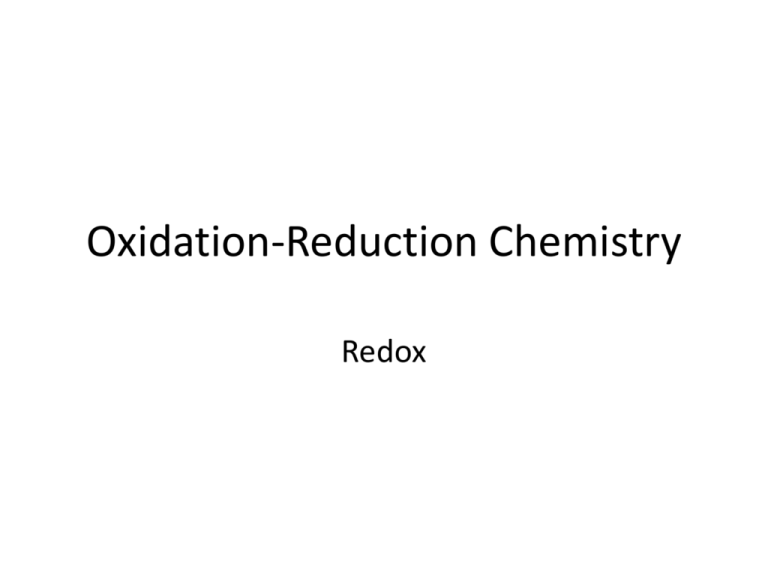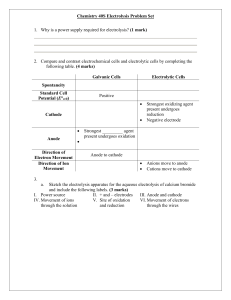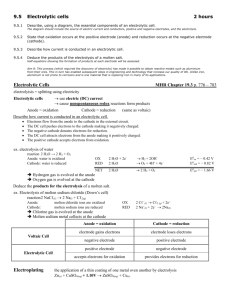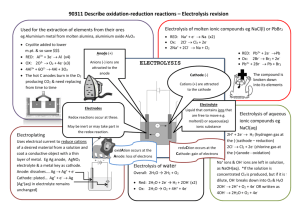Oxidation-Reduction Chemistry
advertisement

Oxidation-Reduction Chemistry Redox Definitions Oxidation: Reduction: Oxidizing Agent: Reducing Agent: Examples: 2 Ag+(aq) + Cu(s) 2 Ag(s) + Cu2+(aq) MnO4-(aq) + 5 Fe2+(aq) + 8 H+(aq) Mn2+(aq) + 5 Fe3+(aq) + 4 H2O(l) Electrochemical Cells: Batteries Anode: Cathode: Reduction potential: measure of how much the reactant wants to gain electrons to form product. Rank oxidizing and reducing agents. Reduction Potentials and Cell Potentials Eocell = Eocathode – Eoanode more positive = more favored What is the standard cell potential for a cell using: Al Al3+ and Hg2+ Hg Go = -nFEo F = 96485 J/mol When is a cell reaction favored? What is Go for a cell using Cu2+ Cu and Zn Zn2+ Predicting favored reactions from the table Eo = Eo cathode - Eo anode Eo = Eo forward half reaction - Eo reversed half reaction If Eo relates to Go, it must relate to K. Go = -RT lnK Go = -nFEo At 298 K, RT/F = 0.0257 V, so: Cell potentials under nonstandard conditions Nernst Equation: When concentrations differ Recall Q Predict E vs. [products] or [reactants] Concentration Cells What is the potential of a cell that contains a Cu wire and [Cu2+] = 1.5 M in the cathode compartment and a Cu wire and [Cu2+] = 0.00058 M in the anode compartment? Cu2+ + Cu Cu + Cu2+ Concentration Cells Real use of concentration cells: measure E to determine concentration. [H+] in cathode half-cell = 1.00 M [H+] in anode half-cell = 4.6 x 10-4 M E=? Electrolysis: Coulometry– Counting Use electrical energy to effect chemical change: Use an applied voltage to make a cell run “backwards.” One of only three methods to get products from thermodynamically unfavorable reactions. Electrolysis: Coulometry– Counting electrons 1 C = 1 Amp x 1 sec 96485 C = 1 mol eHow many grams of Cu can be deposited from a Cu2+ solution by applying a current of 1.68 A for 22 minutes? Electrolysis of Molten Salts NaCl melts at about 801 oC. Use a mixture of CaCl2 and NaCl is used. Melts at 580 oC. Electrolysis of Molten Salts A current of 7.06 A is passed through an electrolysis cell containing molten CaCl2 for 12.9 minutes. a. Predict the products of the electrolysis and the reactions occurring at the cathode and anode. Electrolysis of Molten Salts A current of 7.06 A is passed through an electrolysis cell containing molten CaCl2 for 12.9 minutes. b. Calculate the quantity or volume of products collected at the anode and cathode (assume gases are collected at 298 K and 1.00 atm). Electrolysis of Molten Salts A current of 7.06 A is passed through an electrolysis cell containing molten CaCl2 for 12.9 minutes. b. Calculate the quantity or volume of products collected at the anode and cathode (assume gases are collected at 298 K and 1.00 atm). Batteries Alkaline Battery Cathode: 2 MnO2(s) + H2O(ℓ) + 2 e− Mn2O3(s) + 2 OH−(aq) Anode: Zn(s) + 2 OH−(aq) ZnO(s) + H2O(ℓ) + 2 e− Net reaction: 2 MnO2(s) + Zn(s) Mn2O3(s) + ZnO(s) Ecell = 1.5 V Cathode: 2 MnO2(s) + H2O(ℓ) + 2 e− Mn2O3(s) + 2 OH−(aq) Anode: Zn(s) + 2 OH−(aq) ZnO(s) + H2O(ℓ) + 2 e− Net reaction: 2 MnO2(s) + Zn(s) Mn2O3(s) + ZnO(s) Ecell = 1.5 V Dead Alkaline Battery Watch Battery Cathode: HgO(s) + H2O(ℓ) + 2e− Hg(ℓ) + 2 OH−(aq) Anode: Net reaction: Zn(s) + 2 OH−(aq) ZnO(s) + H2O(ℓ) + 2 e− HgO(s) + Zn(s) ZnO(s) + Hg(ℓ) Ecell = 1.3 V Lead Acid Battery Cathode: Anode: PbO2(s) + 2 H2SO4(aq) + 2 e− PbSO4(s) + 2 H2O(ℓ) Pb(s) + SO42-(aq) PbSO4(s) + 2 e− Net reaction: PbO2(s) + Pb(s) + H2SO4(aq) 2 PbSO4(s) + 2 H2O(ℓ) Recharging: 2 PbSO4(s) + 2 H2O(ℓ) PbO2(s) + Pb(s) + H2SO4(aq) Rechargeable Batteries Nickel Metal Hydride Batteries Cathode: NiO(OH)(s) + H2O(ℓ) + e− 2 Ni(OH)2(s) + OH−(aq) Anode: MH(s) + OH−(aq) M(s) + H2O(ℓ) + e− Net reaction: MH(s) + NiO(OH)(s) M(s) + Ni(OH)2(s) Lithium Ion Batteries Cathode: CoO2(s) + Li+ + 1 e− LiCoO2(s) Anode: Net reaction: Li-graphite C(graphite) + Li+ + e− Li(s) + CoO2(s) LiCoO2(s) Rechargeable Batteries What is required for a battery to be rechargeable? Reduction potential: measure of how much the reactant wants to gain electrons to form product. Rank oxidizing and reducing agents. Reduction Potentials and Cell Potentials Eocell = Eoanode – Eocathode more positive = more favored What is the standard cell potential for a cell using: Al Al3+ and Hg2+ Hg Go = -nFEo F = 96485 J/mol When is a cell reaction favored? What is Go for a cell using Cu2+ Cu and Zn Zn2+ Predicting favored reactions from the table Cell potentials under nonstandard conditions Nernst Equation








